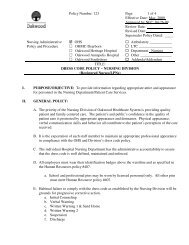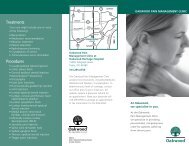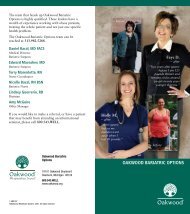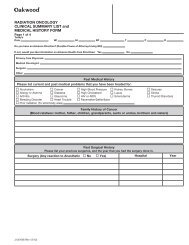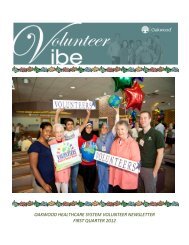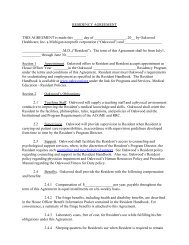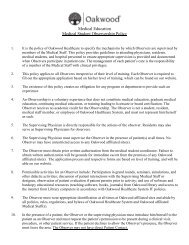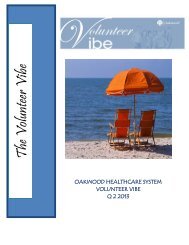Volunteer - Oakwood Annapolis Hospital
Volunteer - Oakwood Annapolis Hospital
Volunteer - Oakwood Annapolis Hospital
You also want an ePaper? Increase the reach of your titles
YUMPU automatically turns print PDFs into web optimized ePapers that Google loves.
<strong>Oakwood</strong> Donates Heart Attack Treatment<br />
Units to Dearborn Fire Department<br />
<strong>Oakwood</strong> Healthcare System donated five portable 12-lead EKG units to the Dearborn Fire Department, furthering a<br />
commitment to reduce heart attack treatment times throughout the Detroit metro area.<br />
The units, which represent an investment of $165,000 by the healthcare system, are capable of transmitting EKG<br />
information directly to the smart phones of attending physicians, dramatically reducing the treatment times for heart<br />
attack victims. It’s part of a commitment from <strong>Oakwood</strong> to provide the equipment and training to paramedics<br />
throughout the 500-square-mile area serviced by <strong>Oakwood</strong>.<br />
“This is a huge commitment, not only to the City of Dearborn, but to the entire region,” said Jeffrey Beutner, Battalion<br />
Chief, Emergency Medical Services for the City of Dearborn. “This is a wonderful thing the hospital has done.”<br />
rather than going to the hospital on their own.<br />
“We’ve consistently seen 30 minutes or less when patients are transported by our agency,” said Beutner.<br />
Healthcare systems rate<br />
the time between the<br />
arrival of heart attack<br />
patients at an emergency<br />
room and when they can<br />
receive an emergency<br />
catherization—it’s referred<br />
to as door-to-balloon time.<br />
The national average is<br />
about 90 minutes. Since the<br />
new technology has been<br />
implemented at the<br />
<strong>Oakwood</strong> <strong>Hospital</strong> &<br />
Medical Center (OHMC) in<br />
Dearborn, the average is<br />
about 53 minutes—and far<br />
less if patients are<br />
transported by the<br />
Dearborn Fire Department,<br />
That’s because doctors can make the diagnosis as soon as the information is transmitted to their phones, said Joe<br />
Murray Ph.D., manager of the Critical Care transport Team at <strong>Oakwood</strong> <strong>Hospital</strong> & Medical Center.<br />
“By the time the fire department gets to the hospital, our staff is ready to go,” said Murray.<br />
Beutner said the units would find regular use in Dearborn. The four ambulance units in the city respond to about 10,000<br />
calls every year. They go on at least three cardiac runs every day, he said.<br />
The Dearborn Fire Department has used the technology since 2009, according to Beutner. The new units will replace old<br />
ones that have seen plenty of use for the department.<br />
“It’s been a great partnership,” said Dearborn Mayor Jack O’Reilly.<br />
“It’s huge,” said Fire Chief Richard Miller of the donation, which comes at a time when many municipalities are<br />
operating under tight budget conditions. “This is a big help for the department and the community as a whole.”<br />
<strong>Volunteer</strong> Vibe – 3 rd Quarter Page - 7 -



